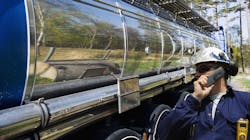How to maximize efficiency and simplify dispatcher experience in O&G upstream trucking
The U.S. is currently experiencing an exponential surge in oil and gas production. With the U.S. rig count up by 271 rigs in June 2022 compared to the same time last year and major conflict overseas, crude oil prices have risen dramatically, translating into skyrocketing gas prices at the pump. These rising prices are impacting businesses across the O&G industry, which rely heavily on large fleets to conduct daily business deliveries and operations. As a result, oil and natural gas producers face the same supply chain issues pinching most enterprises across the country. With no reprieve from the pain at the pumps in sight, the trickle-down effects have become a harsh reality for dispatchers hamstrung with inaccessibility to the spare parts, engines, electronics, and other inputs needed to keep their fleets up and running efficiently.
Key issues
Before resolving a problem, it’s crucial first to understand the concerns. Some issues that are currently plaguing O&G trucking operations include:
- Labor shortage: There are not enough drivers to make necessary deliveries across the country, including in the O&G upstream sector. That means dispatchers are managing fleets that are stretched thin and often unable to handle all the jobs necessary to maximize the bottom line.
- Delays: There are currently months-long delays in securing steel pipe and casing used for drilling. If there’s no pipe, there’s no drilling, and steel casing is necessary to prevent environmental impacts.
- Rising costs: Fuel costs are teetering around the highest we’ve ever seen, collectively, as a country; cement costs are up 43%; directional drilling costs are up 35%; and equipment rentals are up more than 20%.
- Trucking issues: When fleets are transporting water to wells and drill sites, trucks can absorb more resources, take longer, and damage roadways if not managed efficiently.
Finding a solution by digitizing the human process
Figuring out the best way to address the supply chain issues, empower dispatchers, maintain equipment, and maximize the productivity of a stretched workforce has been a major hurdle. However, there’s a way to tackle these issues and bolster the bottom line: mobile field operations management solutions. Cloud-based software is the most efficient way to maximize the productivity of a stretched workforce, ensuring there are no delays at the site and expediting the overall workflow process. It can streamline a slew of tasks and help companies recover revenue, ultimately maximizing a dispatcher’s efficiency.
Plenty of digital transformation solutions modules can be integrated into the workflow to help automate tasks. Some of them include:
- Complete route view: Routes can be created with convenient drag-and-drop functionality, making it easy to schedule the route with the driver. This allows dispatchers to plan all routes for the day prior to dispatch. Once the correct schedule for the day is created, the routes can then be dispatched to the drivers, sending a notification to their mobile apps.
- Data collection: Dispatchers can easily capture proof of delivery and the location of their drivers and assets directly on a tablet or PC screen. Geofencing capabilities also allow dispatchers to track the exact time their employees have reached or left the client site. Utilizing a technology that can collect data quickly and safely will create a seamless process that eliminates the risk of errors.
- Mobile applications: Mobile applications can provide a guided approach to loading and unloading materials such as fluids, sand, chemicals, or equipment from one location to another. They can also provide two-way communication between the driver and dispatcher via the electronic messaging system
- e-ticketing: From operations to field personnel and invoicing, the entire field ticketing process can be managed in the office or in the field, online or off, eliminating any delays. e-Ticketing can also help manage water transfer services and offers a cost-effective solution for hauling frac tanks.
- Analytics: Custom reports are made using data collected from field operations. Instead of workers having to make sense of the data themselves, they can save time and redirect their energy to other matters. These reports can also improve decision-making on all fronts.
- Maintenance: The technology uses computing devices to gather asset data, monitor the conditions of assets in the oil fields, and understand the overall health of an asset. Digitized maintenance can schedule the upkeep of assets, as well as make sure they are compliant. This increases uptime, decreases labor costs, and boosts economic output.
In addition to the many ways mobile field operations can help with tasks on the road and in the field, some modules can assist in configuring and price quoting, asset management, forms recreation, and more. Plus, field personnel are often in remote areas without reliable internet service. However, with mobile field operations, they can still perform their job, make changes to tickets, attach any relevant photos or documents, and record any significant site data.
The bottom line is that even when prices are high and there are supply chain issues and a labor shortage, the use of cloud-based trucking modules can provide a seamless experience for the dispatcher. This ultimately saves money through improved efficiency and higher driver utilization—keeping fleets moving.
Matt Danna is the senior director of product strategy at ServiceMax and has worked in software for over 25 years. Danna’s background brings a depth of knowledge in software engineering, sales engineering, and product management. His primary function is to work with customers, key stakeholders, implementation managers, account executives, and developers to ensure alignment across all parties.
About the Author

Matt Danna
Senior Director of Product Strategy | ServiceMax
Matt Danna is the senior director of product strategy at ServiceMax and has worked in software for over 25 years. Danna’s background brings a depth of knowledge in software engineering, sales engineering, and product management. His primary function is to work with customers, key stakeholders, implementation managers, account executives, and developers to ensure alignment across all parties.
